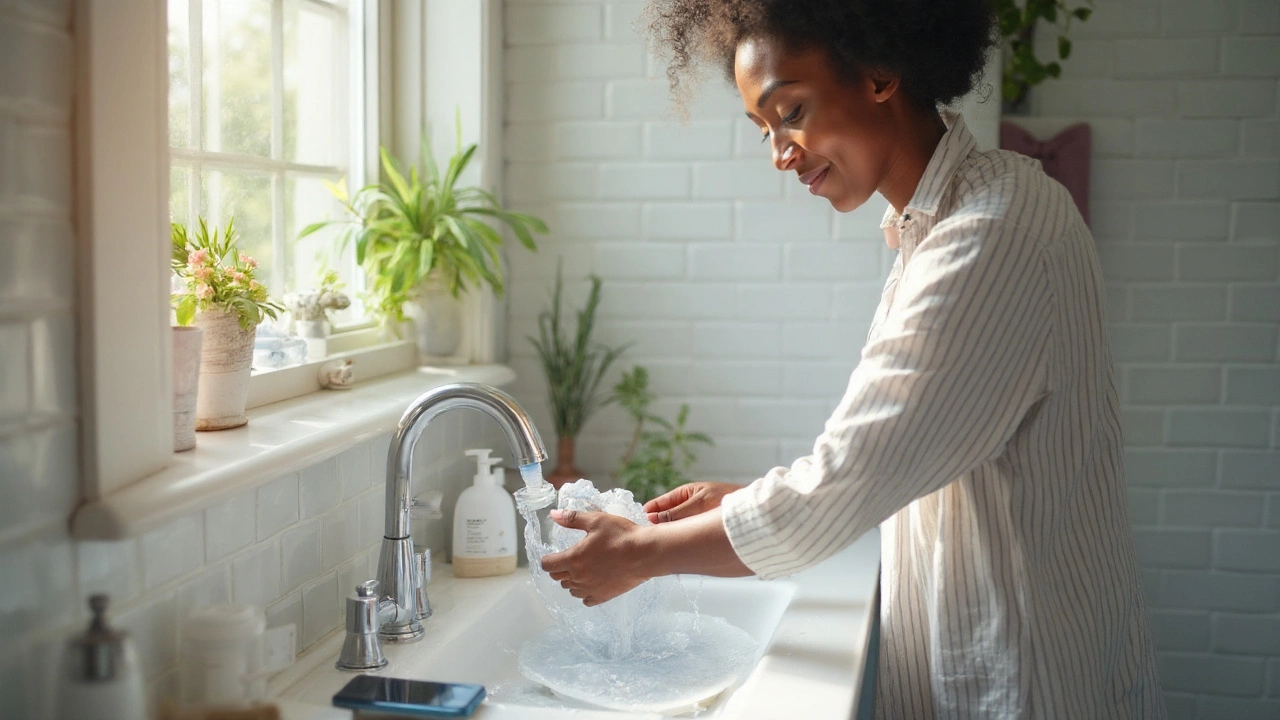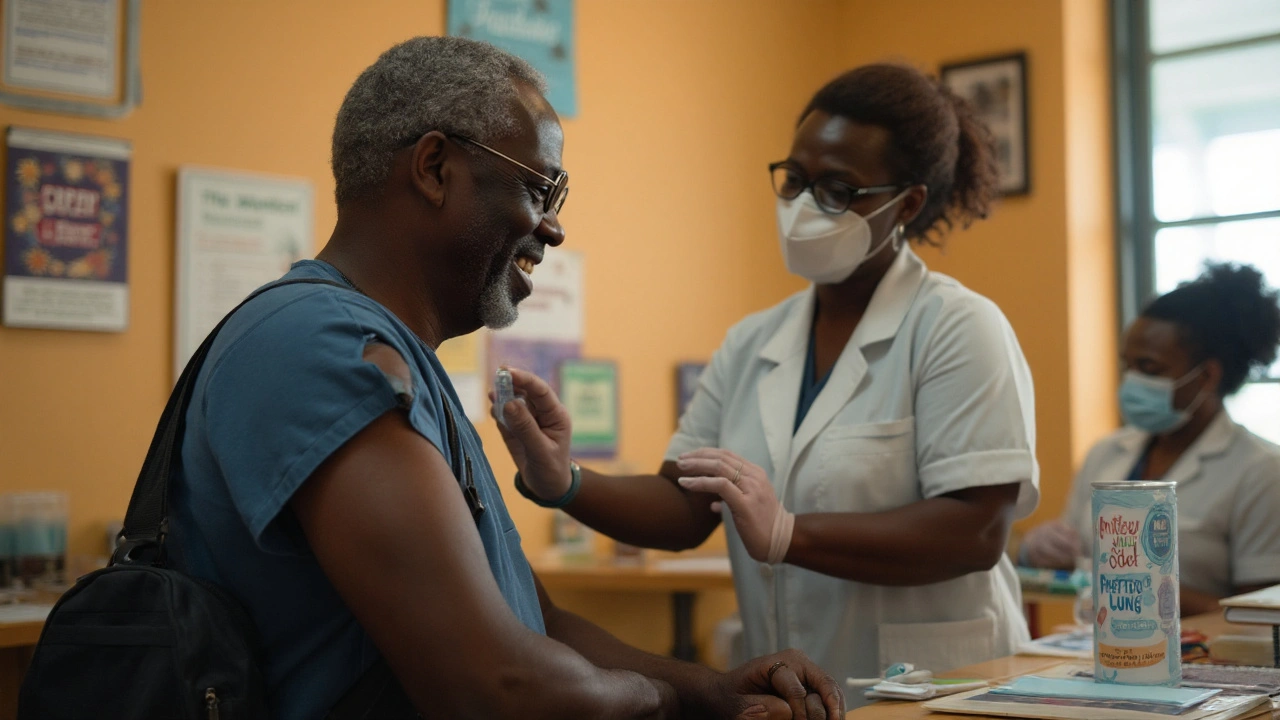If you’ve ever wondered whether your sleep apnea could make pneumonia more likely, you’re not imagining it. The two conditions cross paths more than most people think. The link isn’t just about snoring-it’s about airway stability, micro-aspiration, immune stress, and, for CPAP users, cleaning routines that make a real difference. This guide gives you the short version first, then clear, no-nonsense steps to lower your risk and spot trouble early.
- Sleep apnea increases pneumonia risk, mainly through micro-aspiration (tiny amounts of saliva or stomach contents slipping into the lungs) and immune strain from low oxygen at night.
- CPAP doesn’t cause pneumonia-but poor device hygiene and using tap water in the humidifier can. Good cleaning habits flip that risk the right way.
- Big risk boosters: severe OSA, obesity, reflux, alcohol at night, poor oral hygiene, older age, lung disease, and sedation after surgery.
- Simple prevention works: side-sleeping, elevating the head of the bed, reflux control, vaccines, nasal care, and sticking with well-maintained CPAP.
- See a doctor fast if you get fever, chest pain, breathlessness, or a cough that worsens-especially if you have OSA or you’re over 65.
What you need to get done here:
- Understand why sleep apnea raises pneumonia risk and who’s most affected.
- Decide whether CPAP lowers or raises your personal risk-and what habits fix it.
- Put a simple prevention plan in place you’ll actually follow.
- Know warning signs and when to get help.
- Have a quick checklist for cleaning, vaccines, and travel routines.
What actually links sleep apnea to pneumonia (and who’s most at risk)
Sleep apnea (especially the obstructive type, OSA) isn’t just noisy breathing. Your airway collapses repeatedly at night. That triggers drops in oxygen, pressure swings in the chest, and inflammation that disrupts your immune system’s guard duty. It also makes you more likely to aspirate tiny amounts of saliva or stomach contents-especially if you have reflux. Put those together, and the lungs get exposed to bacteria at the same time your defenses are a bit distracted.
Here’s the short physiology tour, minus the jargon:
- Micro-aspiration: During apneas, the airway muscles relax, and swallowing becomes uncoordinated. A little fluid going the wrong way adds up over many nights.
- Reflux tie-in: OSA raises abdominal pressure swings, which can push stomach acid upward. Acid and bacteria at the top of the airway aren’t great for the lungs.
- Immune stress: Intermittent low oxygen ramps up inflammation and oxidative stress. Your body is busy putting out fires instead of patrolling for germs.
- Airway dryness: Mouth breathing and unhumidified CPAP dry out mucosa, slowing cilia that normally sweep out microbes.
So yes, there’s a real connection: pneumonia and sleep apnea go together more than chance would suggest. Large studies back it up. A nationwide cohort study in CMAJ (2014) tracked adults with OSA and found a higher incidence of pneumonia compared with matched controls, with risk rising as OSA severity increased. A 2018 meta-analysis in Sleep and Breathing reported higher odds of pneumonia in people with OSA, again showing a severity gradient. In hospital settings, research published in chest and respiratory journals has linked untreated OSA to postoperative respiratory complications, including aspiration-related events.
What about CPAP? It stabilises the airway, cuts apnea events, and can improve oxygen levels. That should lower aspiration risk at night. But there’s a flip side: poor CPAP hygiene can seed bacteria in the mask, hose, or humidifier. Studies in infection control journals have cultured pathogens from neglected CPAP setups-think tap-water mineral biofilms or humidifier tanks that never fully dry. The takeaway isn’t to avoid CPAP. It’s to use it well and clean it right.
| Evidence | Population | Key finding | What it means for you |
|---|---|---|---|
| CMAJ, 2014 (nationwide cohort) | Adults with diagnosed OSA vs matched controls | Higher pneumonia incidence; risk rose with OSA severity | More severe OSA, more pneumonia risk-treatment matters |
| Sleep and Breathing, 2018 (meta-analysis) | Multiple observational studies | OSA associated with increased odds of pneumonia | The link holds across studies, not just one dataset |
| Perioperative studies (chest/resp journals) | Surgical patients with OSA | More aspiration events and respiratory complications when OSA untreated | Tell your surgical team about OSA; bring and use CPAP post-op |
| Device hygiene studies | CPAP users | Contaminants found in humidifiers/tubing with poor cleaning | Clean gear properly; use distilled water; let parts dry fully |
Risk boosters worth your attention:
- Severe OSA (higher apnea-hypopnea index)
- Obesity, especially with neck circumference increase
- GERD or frequent heartburn
- Alcohol or sedatives within 3-4 hours of bed
- Chronic lung disease (asthma, COPD), smoking or vaping
- Age 65+, frailty, or trouble with swallowing
- Recent surgery or being bedridden
- Poor oral hygiene or gum disease
If you see yourself in a few of those, your prevention plan matters even more.

Cut your risk: a practical plan for CPAP users and non‑users
Here’s a straight, doable plan. Start with where you are-untreated OSA, using CPAP, or not sure.
If you think you have OSA but aren’t diagnosed yet
- Check your signs: loud snoring, choking at night, morning headaches, dry mouth, daytime sleepiness, high blood pressure, or bed partner noticing pauses.
- Get tested: ask for a home sleep apnea test if your risk is high and you’re otherwise healthy; book an in-lab study if you have heart, lung, or neuromuscular conditions.
- Start treatment quickly if positive: CPAP is first-line for moderate to severe OSA; oral appliances help in mild to moderate cases or if CPAP doesn’t suit you.
- Pair it with simple habits: side-sleeping, head-of-bed elevation (10-15 cm), nasal rinses at night, and reflux control (see below).
If you use CPAP
- Use it nightly, all night. Short, patchy use misses the point.
- Humidify smartly: use distilled water; empty and air-dry the tank daily; wash and dry weekly.
- Clean on a schedule (see checklist below). Skip ozone gadgets that can damage plastics and irritate airways.
- Fit matters: leaks dry out your mouth and nose and can push air into your stomach, feeding reflux. Get your mask refit if you’re fighting it every night.
- If you get sinus infections or cough after starting CPAP: check humidity settings, fix leaks, and audit your cleaning routine. If that fails, talk to your clinician.
Reflux control (works for both CPAP and non‑CPAP users)
- Stop eating 3 hours before bed. No heavy, spicy, or fatty meals at night.
- Skip alcohol within 3-4 hours of bed. Alcohol relaxes airway muscles and worsens reflux.
- Elevate the head of the bed 10-15 cm. Wedges beat extra pillows.
- Ask your GP about a trial of acid suppression if symptoms or dental enamel wear suggest reflux.
Vaccines and seasonal timing (Australia)
- Influenza: yearly, ideally before winter. In Brisbane, most people aim for April-May.
- Pneumococcal: recommended for older adults and people with certain medical conditions. Check your eligibility under the National Immunisation Program with your GP or pharmacist.
Daily airway care
- Nasal rinse with isotonic saline in the evening if you’re stuffy. Clear nose, calmer mouth breathing.
- Brush and floss before bed. A cleaner mouth reduces the bacteria available to be aspirated.
- Hydrate during the day, not right before bed.
- Side-sleeping beats supine. If you flip onto your back, try a positional trainer or a backpack hack.
CPAP cleaning checklist (no guesswork)
- Daily: empty humidifier; rinse with warm water; air‑dry the tank and mask cushion; top up with fresh distilled water before bed.
- Weekly: wash mask, headgear, and humidifier tank in warm, soapy water (mild dish soap); rinse well; air‑dry out of direct sun; rinse tubing and hang to dry.
- Filters: check weekly; replace disposable filters monthly or sooner if discoloured; clean reusable filters per manufacturer’s guide.
- Replacements (typical): mask cushion 1-3 months; tubing 6-12 months; tank 6-12 months; headgear 6-12 months (or when it stretches out).
- Never: use tap water in the humidifier; use harsh chemicals, bleach, or fragrant oils; reassemble while damp.
Travel and emergencies
- Pack a small bottle of distilled water. If you can’t get it, run CPAP without water rather than using tap water for a night or two.
- Quick clean kit: travel-size dish soap, microfiber cloth, and a hanger for tubing.
- During flu surges: wear a mask in crowded indoor spaces, prioritise sleep, and keep your CPAP cleaning on point.
Weight, fitness, and timing
- Even 5-10% weight loss can reduce OSA severity, which likely lowers pneumonia risk too.
- Gentle aerobic exercise (like brisk walking 30 minutes most days) helps airway tone, mood, and immunity.
- Aim for consistent sleep windows; chaotic sleep timing can worsen reflux and airway collapsibility.
Red flags to seek care now
- Fever, shaking chills, or sweats
- Cough with green/rust sputum, blood, or chest pain on breathing
- Breathlessness at rest, fast breathing, or oxygen readings trending down if you use a pulse oximeter
- Confusion or sleepiness out of character (especially in older adults)

Spotting trouble early: symptoms, decisions, and real‑world answers
How do you tell a CPAP‑related irritation from actual pneumonia? Dry nose and a mild cough right after starting CPAP are common and usually settle with better humidity and mask fit. Pneumonia tends to come with fever, deeper fatigue, breathlessness, and chest discomfort. If in doubt, get checked-chest exam and, if needed, a chest X‑ray will sort it out.
Decision hints
- Cough without fever, mostly morning: think post‑nasal drip or dry air. Adjust humidity; add nasal rinse.
- Cough with fever and breathlessness: treat as possible pneumonia; seek medical care the same day.
- New cough after starting CPAP and you used tap water: stop, clean thoroughly, switch to distilled water, and see a clinician if symptoms persist or you feel unwell.
- Post‑op and very sleepy with snoring: use CPAP if prescribed, keep head elevated, alert nurses or your partner to watch your breathing, especially the first few nights.
Mini‑FAQ
- Can CPAP cause pneumonia? Not by itself. Poor cleaning or using tap water can introduce germs. Good hygiene flips risk in your favour by stabilising the airway and reducing aspiration.
- Is OSA a risk factor for severe respiratory infections? Yes, OSA is linked with higher rates of lower respiratory infections in observational data. Severity and comorbidities (like obesity or diabetes) add to that risk.
- Does mouth taping increase pneumonia risk? If you’re using CPAP with proper settings and no nasal blockage, mouth taping isn’t necessary and can be unsafe for some. If you’re congested, forcing nasal breathing can backfire. Talk to your sleep clinician first.
- Is there a best sleep position? Side‑sleeping helps. Back‑sleeping worsens OSA and reflux in many people. A body pillow can keep you honest.
- What water should I use in my humidifier? Distilled water only. If you’re stuck, run dry for a night rather than using tap water.
- Do I still need vaccines if I’m young? Flu-yes, every year. Pneumococcal-depends on your medical history. Ask your GP or pharmacist; in Australia, eligibility depends on age and risk factors.
- How often should I replace CPAP parts? Cushion 1-3 months, tubing and tank 6-12 months, filters monthly (disposable). If something looks grimy or smells, replace earlier.
- Does losing weight fix the risk? It helps a lot but isn’t instant. Keep treating OSA while you work on weight and fitness.
Common pitfalls to avoid
- Skimping on CPAP use because the mask is annoying-get refit, don’t give up.
- Using tap water “just this once” and forgetting you did it three more times.
- Cleaning gear but reassembling it damp-moist plastic is germ‑friendly.
- Late‑night wine as a sleep aid-alcohol worsens OSA and reflux.
- Assuming a mild cough is harmless when you also have fever and breathlessness-get checked.
Quick prevention cheat‑sheet
- Night routine: side‑sleep, head elevated, no food or alcohol 3-4 hours before bed.
- Nasal: saline rinse if congested; adjust CPAP humidity to comfort.
- Oral hygiene: brush and floss; consider a gentle antiseptic rinse if your dentist’s fine with it.
- CPAP: distilled water only; dry parts daily; deep‑clean weekly; replace on schedule.
- Seasonal: flu shot before winter; check pneumococcal eligibility.
What to ask your doctor
- Do I need a home sleep test or in‑lab study?
- Is my OSA mild, moderate, or severe-and what does that mean for infection risk?
- Should I adjust my CPAP pressure or humidity?
- Could reflux be at play-and should we treat it?
- Am I eligible for a pneumococcal vaccine under the current program?
Evidence notes (plain English)
Large, well‑done studies show a link between OSA and pneumonia risk. The risk increases with OSA severity. CPAP, when used and maintained properly, likely reduces aspiration risk; poor hygiene can add risk back. These findings appear across different countries and study designs. That’s why your habits-how you sleep, how you clean, and how steady you are with treatment-make such a big difference.
Next steps by scenario
- Untreated snorer with reflux: book a sleep assessment; start side‑sleeping and head‑of‑bed elevation tonight; stop late meals and alcohol; ask about a reflux trial.
- New CPAP user with dry cough: increase humidity one step; check mask leaks; start nightly saline rinse; audit cleaning; if fever or breathlessness appear, see a doctor.
- Older adult or caregiver: set up a weekly cleaning routine and a vaccine check; watch for confusion or new breathlessness-these can be pneumonia in older adults.
- Post‑surgery patient with OSA: tell your team; bring your CPAP; use it when you nap; keep the bed head up; avoid sedatives if possible.
- Brisbane winter prep: get your flu shot early in the season, keep CPAP cleaning tight during peak viruses, and use saline rinses if smoke or pollen flares your nose.
Bottom line? Treat the OSA, respect the reflux, clean the gear, and don’t ignore warning signs. That’s how you keep lungs out of trouble.


Megan Raines
So let me get this straight - sleeping with a machine on my face is riskier than just snoring? And I thought my cat was the problem.
But okay, I’ll clean the hose. Maybe.
Mamadou Seck
CPAP is just a fancy air pump with a side of guilt
people act like its magic but if you dont clean it its just a germ factory
also who has time for all this
im just gonna sleep on my side and hope for the best
Wayne Keller
Love this breakdown. Real talk - if you’re using tap water in your humidifier, you’re basically brewing bacteria smoothies.
Distilled water isn’t expensive. Cleaning your mask takes 2 minutes. Do it.
And yes, side sleeping works. I used a tennis ball in a sock behind my back for a month. It’s weird but it saved my lungs.
Small habits > grand gestures.
You don’t need to be perfect. Just consistent.
Shana Labed
OMG YES I’VE BEEN DOING THIS WRONG 😭
My CPAP tank looked like a science experiment last week and I didn’t even notice
Im switching to distilled water TONIGHT and cleaning everything
Im also getting my flu shot tomorrow - this is my wake up call 💪
Thank you for not sugarcoating it - this is life-saving info
Judy Schumacher
While the article is technically accurate, it fails to address the fundamental flaw in modern sleep medicine: the commodification of health anxiety. The author presumes that every individual with OSA is a passive recipient of clinical directives, when in reality, most are overwhelmed by bureaucratic healthcare systems, insurance denials, and the psychological toll of lifelong device dependency. The notion that ‘just clean your mask’ solves systemic issues of access, affordability, and mental health comorbidity is not just reductive - it is ethically negligent. The real risk isn’t pneumonia - it’s the medical-industrial complex profiting from your sleep.
California Daughter
Wait… so if I don’t use CPAP, I’m at risk… but if I do use CPAP, I’m at risk… so what’s the point?
Also, why is distilled water so expensive? Is this a water cartel?
And why does everyone assume I live in a place where I can just ‘go to the pharmacy’? What if I’m in a rural town?
Also, I don’t have a bed. I sleep on the floor. Do I still elevate?
Also, I hate my mask. It makes me look like a robot. Can I just… not?
Also, I’m 23. Why am I being told I need a pneumococcal vaccine?
Also, why is this article 5000 words long?
Also, I’m not sure I believe in pneumonia anymore.
Vishwajeet Gade
USA doctors always overcomplicate everything
in India we just sleep on floor drink warm water and pray
no machines no distilled water no checklists
your lungs are weak because you eat too much pizza and sit on couch
stop blaming CPAP
go outside
Norman Rexford
Look I get it I’m not perfect I drink wine before bed I use tap water sometimes I forget to clean
but I’m not some lazy American who needs a 12-step plan to breathe
my grandpa lived to 92 with a cigarette in one hand and a snore in the other
you people are scared of your own lungs
just stop overthinking
and maybe get a hobby
like fishing
or knitting
or watching paint dry
Casey Crowell
THIS. IS. LIFE-CHANGING. 🙌
I’ve been using my CPAP for 3 years and never cleaned the hose properly… I’m literally crying right now
Also side sleeping changed my life - I used to wake up with my face smashed into the pillow like a raccoon
Now I’m using a body pillow and feeling like a new person
Also I got my flu shot yesterday - I feel like a superhero 💪❤️
Thank you for writing this like a human not a robot
Lorne Wellington
As someone who’s lived with OSA for 15 years and traveled to 27 countries with my CPAP, I can confirm: distilled water is non-negotiable. In Bali, I carried a 2L bottle in my backpack. In Iceland, I boiled tap water and let it cool. In Canada, I bought it in bulk. It’s not about perfection - it’s about intention.
And yes, the mask is ugly. But it’s not a fashion statement - it’s your lifeline.
Also, if you’re over 65 and haven’t gotten the pneumococcal vaccine, talk to your pharmacist. It’s free in most places. Don’t wait for a fever to act.
Jacqueline Anwar
While the article contains a multitude of factual assertions, it fails to interrogate the underlying epistemological framework of biomedical hegemony. The conflation of hygiene protocols with moral virtue - ‘clean gear properly’ - is a classic example of neoliberal biopower, wherein individual responsibility is weaponized to absolve systemic failures in public health infrastructure. Furthermore, the privileging of CPAP as the sole therapeutic modality ignores the efficacy of positional therapy, oral appliances, and weight-neutral approaches, thereby reinforcing a narrow, pathologizing paradigm. One must ask: who benefits from this narrative?
Will RD
People are dying because they dont clean their CPAP
Its not hard
Its not expensive
Its not complicated
Its just laziness
Stop making excuses
And if you cant do it
Then dont use it
Just sleep on your side
And stop whining
Jenni Waugh
Okay but let’s be real - if you’re over 65 and still using tap water in your CPAP, you’re not just risking pneumonia, you’re auditioning for a medical drama.
Also, why is this the first time I’ve heard about distilled water?
My doctor never mentioned it.
My insurance won’t cover it.
So now I’m guilty AND broke?
Also, I’m not getting a vaccine because I don’t trust big pharma.
So… what now?
Shanna Talley
Thank you for writing this like someone actually cares.
I’ve been scared to use my CPAP because I thought it was making me sick.
Now I know it’s not the machine - it’s the mess.
So I cleaned it tonight. Took 10 minutes.
And I’m going to sleep on my side.
And I’m getting the shot.
You don’t have to fix everything at once.
Just fix one thing today.
You’ve got this.
Samuel Wood
While the article presents a superficially coherent framework, its reliance on epidemiological correlation as causal evidence reveals a fundamental epistemological deficit. The author neglects to contextualize confounding variables - namely, the confounding influence of socioeconomic status, dietary patterns, and polypharmacy - all of which are more potent determinants of respiratory infection risk than OSA alone. Furthermore, the recommendation to elevate the head of the bed by 10–15 cm is anatomically dubious without specifying the angle of inclination relative to the Frankfort horizontal plane. One wonders if the author has ever consulted a biomechanics textbook.
Anthony Griek
I’ve been using CPAP for 7 years. Never had pneumonia. But I do clean my mask every week. I use distilled water. I sleep on my side. I don’t eat late. I got the shot.
It’s not magic. It’s just… doing the thing.
Some people think it’s a chore. I think it’s self-respect.
And if you can’t do it - that’s okay. But don’t pretend it’s the machine’s fault.
It’s just a tool. You’re the one who holds it.
Ganesh Kamble
Why is everyone acting like this is new info
My uncle had OSA since 1998 and he never cleaned his machine
He smoked 2 packs a day
Drank whiskey before bed
And he lived to 81
So maybe pneumonia is just part of life
Not a conspiracy
Not a failure
Just… biology
chantall meyer
Interesting. But I notice the author assumes all readers are American. In South Africa, many of us don’t have access to distilled water, let alone CPAP machines. The focus on individual hygiene ignores structural inequality. Also, the suggestion to elevate the bed is impractical for those living in informal settlements. This feels less like guidance and more like cultural imperialism wrapped in medical jargon.
ridar aeen
Some of you are being ridiculous.
Some of you are being brave.
Some of you are being honest.
And some of you are being real.
So I’m gonna say this: if you’re reading this and you’re scared - you’re not alone.
But you’re not broken.
Just… start small.
One night. One clean. One breath.
You’re doing better than you think.
Theresa Ordonda
Author here.
Thank you all for your comments. I didn’t expect this much emotion.
Some of you are angry. Some are scared. Some are tired.
And some - thank you - are just trying.
That’s enough.
One clean mask. One glass of distilled water. One night on your side.
You don’t have to be perfect.
You just have to show up.
And you’re already doing that.
Keep going.